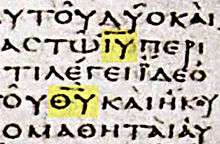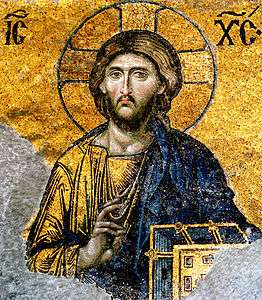Nomina sacra


Nomina sacra (singular: nomen sacrum) means "sacred names" in Latin and refers to the Christian scribal practice of abbreviating several frequently occurring divine names or titles, especially in Greek manuscripts of Holy Scripture. A nomen sacrum consists of two or more letters from the original word spanned by an overline.
Metzger lists 15 such expressions from Greek papyri: the Greek counterparts of God, Lord, Jesus, Christ, Son, Spirit, David, Cross, Mother, Father, Israel, Savior, Man, Jerusalem, and Heaven.[1] These nomina sacra are all found in Greek manuscripts of the 3rd century and earlier, except Mother, which appears in the 4th.[2]
Nomina sacra also occur in some form in Latin, Coptic, Armenian (indicated by the pativ), Gothic, Old Nubian, and Cyrillic (indicated by the titlo).
Origin and development
Nomina sacra are consistently observed in even the earliest extant Christian writings, along with the codex form rather than the roll, implying that when these were written, in approximately the second century, the practice had already been established for some time. However, it is not known precisely when and how the nomina sacra first arose.
The initial system of nomina sacra apparently consisted of just four or five words, called nomina divina: the Greek words for Jesus, Christ, Lord, God, and possibly Spirit. The practice quickly expanded to a number of other words regarded as sacred.[3]
In the system of nomina sacra that came to prevail, abbreviation is by contraction, meaning that the first and last letter (at least) of each word are used. In a few early cases, an alternate practice is seen of abbreviation by suspension, meaning that the initial two letters (at least) of the word are used; e.g., the opening verses of Revelation in 18 write Ἰησοῦς Χριστός (Jesus Christ) as ΙΗ ΧΡ. Contraction, however, offered the practical advantage of indicating the case of the abbreviated noun.
It is evident that the use of nomina sacra was an act of reverence rather than a purely practical space-saving device, as they were employed even where well-established abbreviations of far more frequent words such as and were avoided, and the nomen sacrum itself was written with generous spacing. Furthermore, early scribes often distinguished between mundane and sacred occurrences of the same word, e.g. a spirit vs. the Spirit, and applied nomina sacra only to the latter (at times necessarily revealing an exegetical choice), although later scribes would mechanically abbreviate all occurrences.
Scholars have advanced a number of theories on the origin of the nomina sacra. An obvious parallel that likely offered some inspiration is the Jewish practice of writing the divine name as the Hebrew tetragrammaton even in Greek Scriptures. Greek culture also employed a number of ways of abbreviating even proper names, though none in quite the same form as the nomina sacra. Inspiration for the contracted forms (using the first and last letter) has also been seen in Revelation, where Jesus speaks of himself as "the beginning and the end" and "the first and the last" as well "the Alpha and the Omega".[4] Greek numerals have been suggested as the origin of the overline spanning the whole nomen sacrum, with the suspended form ΙΗ being simply the ordinary way of writing eighteen, for example.[5]
List of Greek nomina sacra
| English Meaning | Greek Word | Nominative (Subject) | Genitive (Possessive) |
|---|---|---|---|
| God | Θεός | ΘΣ | ΘΥ |
| Lord | Κύριος | ΚΣ | ΚΥ |
| Jesus | Ἰησοῦς | ΙΣ | ΙΥ |
| Christ/Messiah | Χριστός | ΧΣ | ΧΥ |
| Son | Υἱός | ΥΣ | ΥΥ |
| Spirit/Ghost | Πνεῦμα | ΠΝΑ | ΠΝΣ |
| David | Δαυὶδ | ΔΑΔ | |
| Cross/Stake | Σταυρός | ΣΤΣ | ΣΤΥ |
| Mother | Μήτηρ | ΜΗΡ | ΜΗΣ |
| God Bearer i.e. Mother of God | Θεοτόκος | ΘΚΣ | ΘΚΥ |
| Father | Πατήρ | ΠΗΡ | ΠΡΣ |
| Israel | Ἰσραήλ | ΙΗΛ | |
| Savior | Σωτήρ | ΣΗΡ | ΣΡΣ |
| Human being/Man | Ἄνθρωπος | ΑΝΟΣ | ΑΝΟΥ |
| Jerusalem | Ἱερουσαλήμ | ΙΛΗΜ | |
| Heaven/Heavens | Οὐρανός | ΟΥΝΟΣ | ΟΥΝΟΥ |
New Testament Greek manuscripts containing nomina sacra (before 300 CE)[6]
| Greek manuscript | Manuscript date | Nomina sacra used |
|---|---|---|
| 1 (P. Oxy. 2) | ΙΥ ΙΣ ΧΥ ΥΥ ΚΥ ΠΝΣ | |
| 4 (Suppl. Gr. 1120) | ΘΣ ΘΥ ΚΥ ΚΣ ΠΝΙ ΠΝΟΣ ΠΝΑ ΧΣ ΙΥ ΙΣ | |
| 5 (P. Oxy. 208 + 1781) | ΙΗΝ ΙΗΣ ΠΡ ΠΡΑ ΠΡΣ ΘΥ | |
| 9 (P. Oxy. 402) | ΘΣ ΧΡΣ | |
| 12 (P. Amherst. 3b) | ΘΣ | |
| 13 (P. Oxy. 657 + PSI 1292) | ΘΣ ΘΝ ΘΥ ΘΩ ΙΣ ΙΝ ΙΥ ΚΣ ΚΥ | |
| 15 (P. Oxy. 1008) | ΚΩ ΚΥ ΧΥ ΑΝΩΝ ΑΝΩ ΠΝΑ ΘΝ ΚΜΟΥ | |
| 16 (P. Oxy. 1009) | ΘΥ ΙΥ ΧΩ | |
| 17 (P. Oxy. 1078) | ΘΩ ΠΝΣ | |
| 18 (P. Oxy. 1079) | ΙΗ ΧΡ ΘΩ | |
| 20 (P. Oxy. 1171) | ΠΝΣ ΚΝ ΘΥ | |
| 22 (P. Oxy. 1228) | ΠΣ ΠΝΑ ΠΡΣ ΠΡΑ ΙΗΣ ΑΝΟΣ | |
| 24 (P. Oxy. 1230) | ΠΝΑ ΘΥ | |
| 27 (P. Oxy. 1395) | ΘΥ ΚΩ | |
| 28 (P. Oxy. 1596) | ΙΣ ΙΝ | |
| 29 (P. Oxy. 1597) | ΘΣ ΘΝ | |
| 30 (P. Oxy. 1598) | ΚΥ ΚΝ ΘΩ ΙΗΥ | |
| 32 (P. Rylands 5) | ΘΥ | |
| 35 (PSI 1) | ΚΣ ΚΥ | |
| 37 (P. Mich. Inv. 1570) | ΚΕ ΙΗΣ ΠΝΑ ΙΗΣΥ | |
| 38 (P. Mich. Inv. 1571) | ΧΡΝ ΠΝΑ ΚΥ ΙΗΝ ΙΗΥ ΠΝΤΑ | |
| 39 (P. Oxy. 1780) | ΠΗΡ ΠΡΑ ΙΗΣ | |
| 40 (P. Heidelberg G. 645) | ΘΣ ΘΥ ΘΝ ΙΥ ΧΩ ΧΥ | |
| 45 (P. Chester Beatty I) | ΚΕ ΚΣ ΚΝ ΚΥ ΣΡΝΑΙ ΙΗ ΙΥ ΙΗΣ ΠΡ ΠΡΣ ΠΡΑ ΠΡΙ ΘΥ ΘΝ ΘΩ ΘΣ ΠΝΙ ΠΝΣ ΠΝΑ ΥΝ ΥΕ ΥΣ ΥΩ ΣΡΝ ΧΡ | |
| 46 (P. Chester Beatty II + P. Mich. Inv. 6238) |
ΚΕ ΚΝ ΚΥ ΚΩ ΚΣ ΧΡΩ ΧΡΥ ΧΡΝ ΧΝ ΧΣ ΧΩ ΧΥ ΧΡΣ ΙΗΥ ΙΗΝ ΙΗΣ ΘΩ ΘΥ ΘΝ ΘΣ
ΠΝΑ ΠΝΙ ΠΝΣ ΥΙΥ ΥΙΝ ΥΙΣ ΥΝ ΣΤΡΕΣ ΣΤΡΝ ΣΤΡΩ ΣΤΡΟΣ ΣΤΡΟΥ ΕΣΤΡΟΝ ΕΣΤΡΑΙ ΕΣΤΑΝ ΣΤΟΥ ΑΙΜΑ ΑΝΟΥ ΑΝΟΝ ΑΝΟΣ ΑΝΩΝ ΑΝΟΙΣ ΠΡΙ ΠΗΡ ΠΡΑ ΠΡΣ ΙΥ | |
| 47 (P. Chester Beatty III) | ΘΥ ΘΣ ΘΝ ΘΩ ΑΘΝ ΚΣ ΚΕ ΚΥ ΕΣΤΡΩ ΠΝΑ ΧΥ ΠΡΣ | |
| 48 (PSI 1165) | ΥΣ | |
| 49 (P. Yale 415 + 531) | ΚΩ ΘΥ ΘΣ ΙΥ ΠΝ ΧΣ ΧΥ ΧΩ | |
| 50 (P. Yal 1543) | ΙΛΗΜ ΠΝΑ ΑΝΟΣ ΘΣ ΘΥ | |
| 53 (P. Mich. inv. 6652) | ΠΡΣ ΙΗΣ ΠΕΡ ΚΝ | |
| 64 (Gr. 17) | ΙΣ | |
| 65 (PSI XIV 1373) | ΧΥ ΘΣ | |
| 66 (P. Bodmer II + Inv. Nr. 4274/4298 |
ΚΣ ΚΥ ΚΕ ΘΣ ΘΝ ΘΥ ΘΩ ΙΣ ΙΝ ΙΥ ΧΣ ΧΝ ΧY ΥΣ ΥΝ ΥΩ ΠΝΑ ΠΝΙ ΠΝΣ
ΠΗΡ ΠΡΑ ΠΡΣ ΠΡΙ ΠΕΡ ΠΡΕΣ ΑΝΟΣ ΑΝΟΝ ΑΝΟΥ ΑΝΩΝ ΑΝΩ ΑΝΟΙΣ ΑΝΟΥΣ ΣΡΩ ΣΡΟΝ ΣΡΟΥ ΣΡΘΗ ΣΡΑΤΕ ΣΡΩΣΩ ΕΣΡΑΝ ΕΣΡΘΗ | |
| 69 (P. Oxy. 2383) | ΙΗΝ | |
| 70 (P. Oxy. 2384 + PSI Inv. CNR 419, 420) |
ΥΝ ΙΣ ΠΗΡ | |
| 72 (P. Bodmer VII and VIII) | ΙΥ ΙΗΥ ΙΗΝ ΧΡΥ ΧΡΝ ΧΡΣ ΧΡΩ ΘΥ ΘΣ ΘΝ ΘΩ ΠΡΣ ΠΑΡ ΠΤΡΑ ΠΡΙ ΠΝΣ
ΠΝΑ ΠΝΑΙ ΠΝΙ ΠΝΤΙ ΚΥ ΚΣ ΚΝ ΚΩ ΑΝΟΙ | |
| 75 (P. Bodmer XIV and XV) | ΙΣ ΙΗΣ ΙΥ ΙΗΥ ΙΝ ΙΗΝ ΘΣ ΘΝ ΘΥ ΘΩ ΚΣ ΚΝ ΚΥ ΚΩ ΚΕ ΧΣ ΧΝ ΧΥ
ΠΝΑ ΠΝΣ ΠΝΙ ΠΝΟΣ ΠΝΤΑ ΠΝΑΣΙ ΠΝΑΤΩΝ ΠΡΣ ΠΗΡ ΠΡΑ ΠΡΙ ΠΡΟΣ ΠΡ ΥΣ ΥΝ ΥΥ ΙΗΛ ΙΛΗΜ Σ ΑΝΟΣ ΑΝΟΝ ΑΝΟΥ ΑΝΟΙ ΑΝΩΝ ΑΝΩ ΑΝΟΥΣ ΑΝΟΙΣ ΑΝΕ | |
| 78 (P. Oxy 2684) | ΚΝ ΙΗΝ ΙΗΝ ΧΡΝ | |
| 90 (P. Oxy 3523) | ΙΗΣ | |
| 91 (P. Mil. Vogl. Inv. 1224 + P. Macquarie Inv. 360) | ΘΥ ΘΣ ΠΡΣ ΧΡΝ ΙΗΝ | |
| 92 (P. Narmuthis 69.39a + 69.229a) | ΧΡΩ ΚΥ ΘΥ | |
| 100 (P. Oxy 4449) | ΚΥ ΚΣ | |
| 101 (P. Oxy 4401) | ΥΣ ΠΝΑ ΠΝΙ | |
| 106 (P. Oxy 4445) | ΠΝΑ ΠΝΙ ΧΡΣ ΙΗΝ ΙΗΣ | |
| 108 (P. Oxy 4447) | ΙΗΣ ΙΗΝ | |
| 110 (P. Oxy. 4494) | ΚΣ | |
| 111 (P. Oxy 4495) | ΙΗΥ | |
| 113 (P. Oxy. 4497) | ΠΝΙ | |
| 114 (P. Oxy. 4498) | ΘΣ | |
| 115 (P. Oxy. 4499) | ΙΗΛ ΑΥΤΟΥ ΠΡΣ ΘΩ ΘΥ ΑΝΩΝ ΠΝΑ ΟΥΝΟΥ ΟΥΝΟΝ ΚΥ ΘΝ ΑΝΟΥ ΟΥΝΩ | |
| 121 (P. Oxy. 4805) | ΙΣ ΜΗΙ | |
| 0162 (P. Oxy 847) | ΙΗΣ ΙΣ ΠΡΣ | |
| 0171 (PSI 2.124) | ΚΣ ΙΗΣ | |
| 0189 (P. Berlin 11765) | ΑΝΟΣ ΠΝΑ ΚΥ ΚΩ ΙΛΗΜ ΘΩ ΙΣΗΛ | |
| 0220 (MS 113) | ΚΝ ΙΥ ΙΝ ΧΥ ΘΥ |
References
- ↑ Bruce Metzger, Manuscripts of the Greek Bible, pp.36-37
- ↑ Text of the Earliest New Testament Greek Manuscripts - Philip Comfort and David Barrett (1999) pp.34-35
- ↑ S. D. Charlesworth, "Consensus standardization in the systematic approach to nomina sacra in second- and third-century gospel manuscripts", Aegyptus 86 (2006), pp. 37-68.
- ↑ Colin H. Roberts, Manuscript, Society, and Belief in Early Christian Egypt (1979), p. 37.
- ↑ Larry Hurtado, "The Origin of the Nomina Sacra: A Proposal", JBL 117 (1998), pp. 655-673.
- ↑ All nomina sacra and dates of manuscripts taken from Text of the Earliest New Testament Greek Manuscripts - Philip Comfort and David Barrett (1999)
Further reading
| Wikimedia Commons has media related to Monograms of the name of Jesus Christ. |
- Don C. Barker, "P.Lond.Lit. 207 and the origin of the nomina sacra: a tentative proposal", Studia Humaniora Tartuensia 8.A.2, 2007, 1–14.
- Philip Comfort and David Barrett. Text of the Earliest New Testament Greek Manuscripts (1999).
- Philip Comfort, Encountering the Manuscripts: An Introduction to New Testament Paleography and Textual Criticism, Broadman & Holman Publishers, 2005, pp. 199–253.
- Larry W. Hurtado, The Earliest Christian Artifacts: Manuscripts and Christian Origins, Cambridge 2006, pp. 95–134.
- Bruce M. Metzger. Manuscripts of the Greek Bible (1981).
- A.H.R.E. Paap, Nomina Sacra in the Greek Papyri of the First Five Centuries, Papyrologica Lugduno-Batava VIII (Leiden 1959).
- Ludwig Traube. Nomina Sacra. Versuch einer Geschichte der christlichen Kürzung, Munich 1907.